The Snapdragon 855 Performance Preview: Setting the Stage for Flagship Android 2019
by Andrei Frumusanu on January 15, 2019 8:00 AM EST- Posted in
- Mobile
- Qualcomm
- Smartphones
- SoCs
- 7nm
- Snapdragon 855
System Performance - Slightly Underwhelming?
While synthetic steady state workloads are one thing, real-world workloads are more transactional and their performance is determined not just by hardware, but as well by software. Here things like the CPU scheduler and OS APIs can have a big effect on the resulting perceived performance of a device.
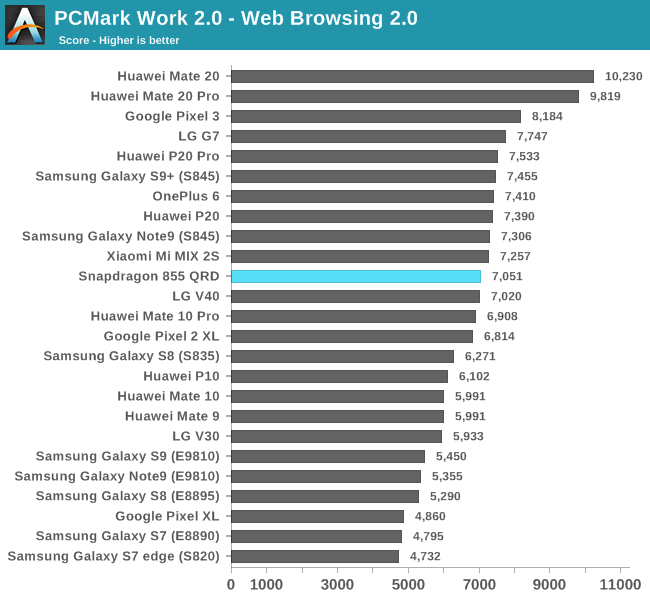
Starting off with PCMark’s Web Browsing 2.0 test, the Snapdragon 855 goes off to a bad start. Here for some reason the S855 QRD wasn’t able to distinguish itself from the lower end of Snapdragon 845 devices – here we had expected the phone to perform and compete similarly to the Kirin 980 in the Mate 20’s.
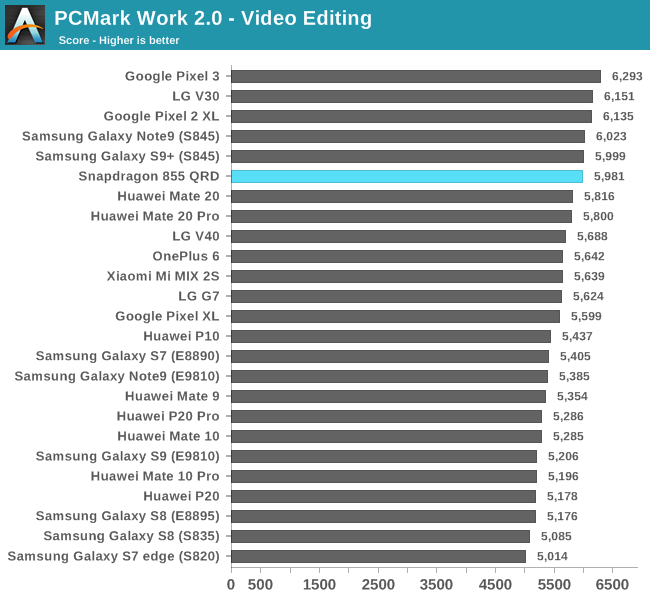
The video editing score is again also quite mediocre, but again the reason for this is that this test has largely reached a performance plateau where most of today’s devices no longer really showcase meaningful differences between each other.
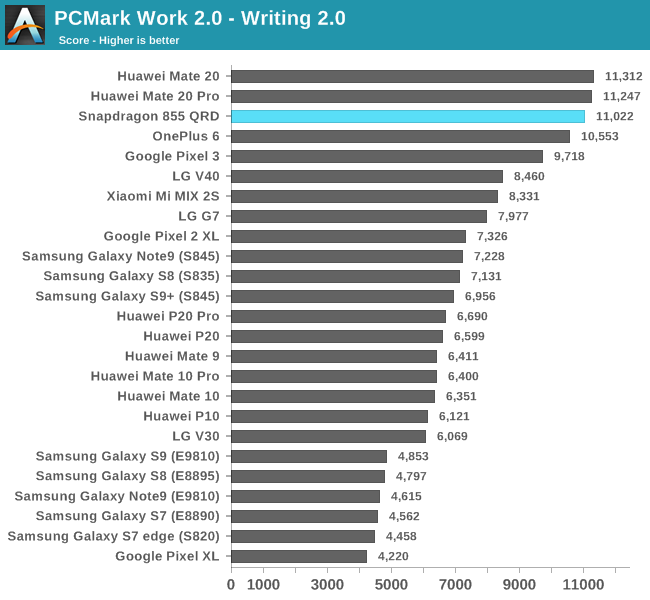
The writing sub-test is among one of the most important in PCMark, and luckily here the Snapdragon 855 QRD performed as expected as it’s within range of the Mate 20’s.
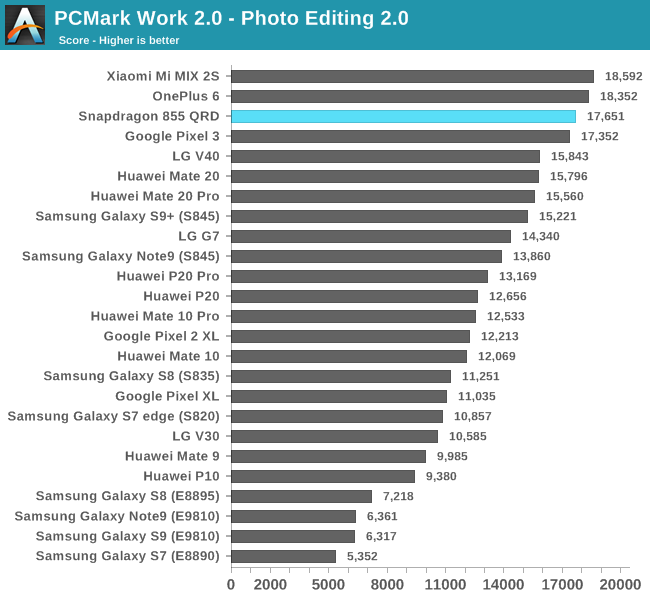
The photo editing sub-test is characterised by shorter heavy RenderScript workload bursts. The QRD performs well, although it’s within the results of the top Snapdragon 845 devices.

Finally in the data manipulation result which is more single-thread bound, we see the Snapdragon 855 perform well, but still remains neck-and-neck with the Kirin 980 devices as well as behind the Pixel 3’s very aggressive scheduler implementation.

Overall, the Snapdragon 855 QRD in PCMark ended up among the top scorers, however I found the result to be a bit disappointing as it doesn’t appear to achieve a higher ranking than the Pixel 3, and Huawei’s Kirin 980 Mate 20’s are also ahead.
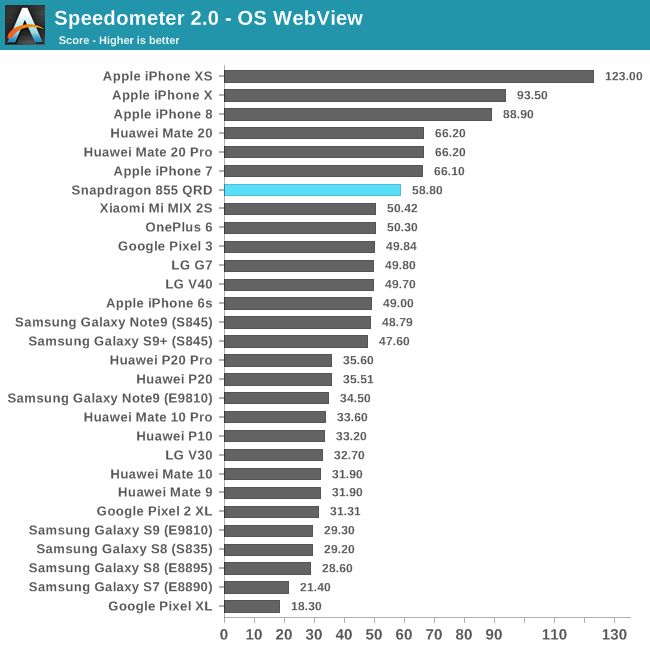
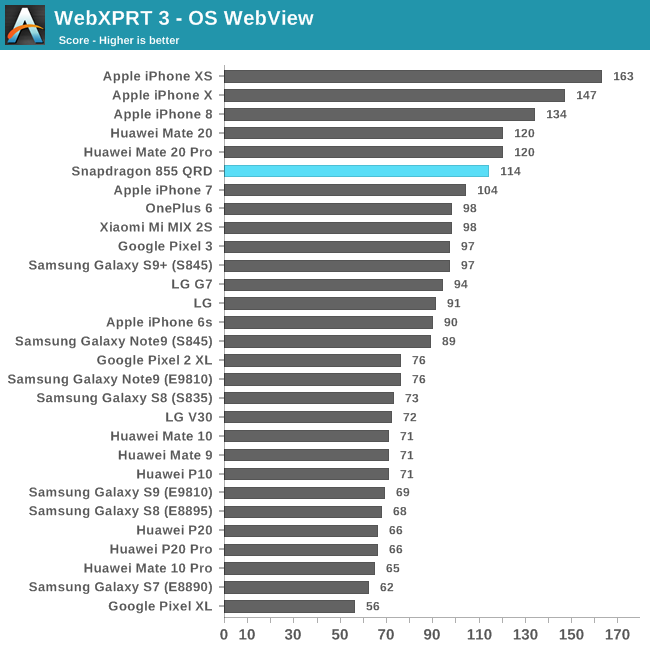
I’ve discussed the results with Qualcomm, and they were surprised to see the numbers end up like this. They stated that it’s something they will look into, and stated that it’s possible that the scheduler and software stack on commercial devices might improve performance. Something to be revisited once we get our hands on the first phones.
The web-based benchmarks such as Speedometer 2.0 and WebXPRT 3 showcase similar relatively muted results. Here I had expected Qualcomm to perform really well given the scheduler performance showcase of the Snapdragon 845. The results of the Snapdragon 855 are quite meagre, especially in a steady-state throughput workload such as Speedometer 2.0. Here the Snapdragon 855 only manages to showcase a ~17% improvement over the last generation, and also lags behind the Kirin 980 by some notable amount.
Performance Scaling Ramp Test
One of the newer kind of tests I introduced last year and has used in our review of the Apple iPhone XS is the scaling ramp test – here showcasing the improved DVFS responsivity of iOS12 across several generations of iPhones.
I’ve quickly ran this on the S855 QRD to be able to get a sense of the scheduler and DVFS mechanism:
Here we see the Snapdragon 855 QRD being able to scale from a sleeping idle workload state to its maximum performance state in around 100ms. To compare this, I also showcase the scaling behaviour of the S845 in both the S9+ as well as the Pixel 3. The difference between the Pixel 3’s aggressive boost behaviour and the S9’s more step-wise frequency scaling showcases the best visual representation of the perceived responsiveness difference between the two devices.
The Snapdragon 855 here falls somewhere in-between both. It’s to be noted that the workload does get boosted to an “efficient” big core at 2.45GHz in around 40ms which is a very fast scaling behaviour.
Comparing the Snapdragon 855 against the Kirin 980, we see that the Snapdragon isn’t any slower in reaching the maximum performance states. What is odd in these results is that the workload sees a significant pause of ~2.4ms when migrating over from the little cores, something that seems to affect only devices with Qualcomm’s custom scheduler. It’s an interesting find that I’ll have to investigate more.
Overall, real-world performance of the Snapdragon 855 is a bit lower than I had expected it to be. I’m not exactly sure what the cause here is; on the scheduler side we’ve verified that the workload doesn’t inherently scale slower than the Kirin 980. The only other explanation I could see is that we might be seeing some disadvantage of the smaller L3 cache or even the higher DRAM latency.
As we’ve seen in past Snapdragon performance previews, final commercial device performance is subject to change, and it’s possible the performance situation will be more tuned in actual shipping phones.


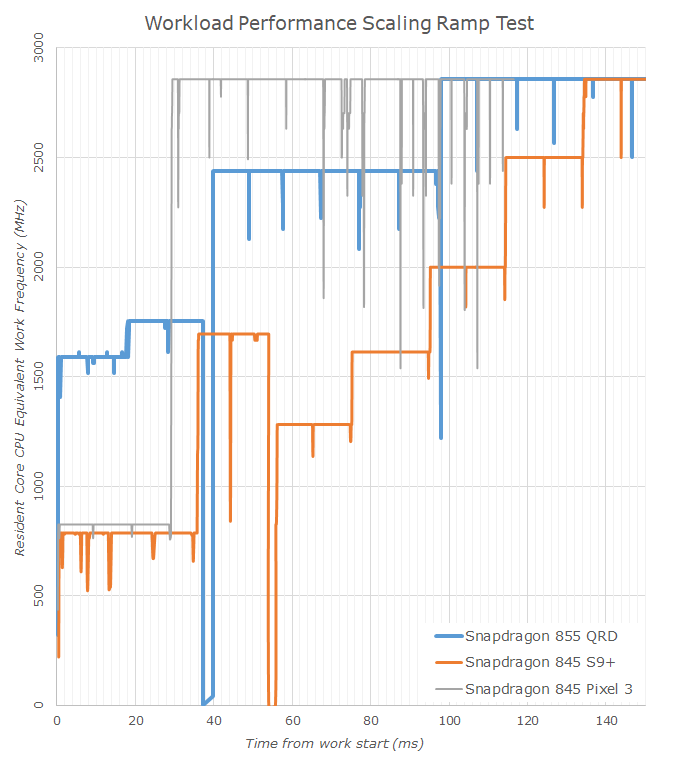
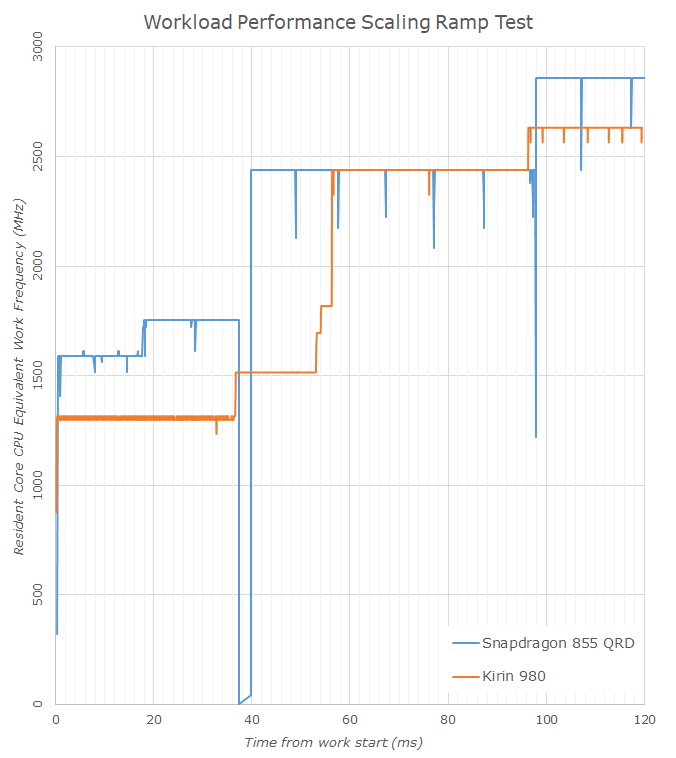








132 Comments
View All Comments
Rudde - Friday, January 18, 2019 - link
Don't cherry-pick results.Rudde - Friday, January 18, 2019 - link
What is raw performance? I could calculate som fused multiplies per second for you, but is that 'raw performance'?HStewart - Tuesday, January 15, 2019 - link
I differ with a lot on this - I think A12/A12X and other ARM related device actually perceive faster because of marketing. Also with App architexture of the OS running on such devices hide the actual performance of chips - I think it specifically depends on what you using the device. For normal word processing, emails and internet - it can easy be shown that same as U series - and this depends on which model - likely dual core x86 and possibly even AMD notebooks - but not a 4+ ghz laptop like my Dell XPS 15 2in1. Keep in mind on a phone and even android tablet or iPad there is less screen to drive. I am talking about real professional software and not appsOne thing is interesting about 855 design is big core designed - running the primary core at higher speed then other 3 primary core - is smart - this means the primary thread is running at higher speed. I assume that smaller cores would be use threads for background tasks. Intel has a similar designed large single core and 3 minor atom based cores - I would think that device is closer on performance to A12 based devices not the U series.
My big question is that I think it hard to actual compare performance between any x86 base and any ARM based. It depends on designed of OS and applications running on devices. I would be 100% sure any software that uses AVX 512 would blow any ARM based application with similar abilities. In fact with AVX 512 application it would be big difference with AVX 2 based computer.
All I am saying is performance depends on application running, not just web browsing and other things
HStewart - Tuesday, January 15, 2019 - link
One thing also - the speed of cpu, number of cores, or even node process does not make the performance of device - it how it used with architexture inside that makes the difference.Wilco1 - Tuesday, January 15, 2019 - link
You're absolutely wrong, A12X can keep up with your beloved laptop - this is the latest and fastest variant: http://browser.geekbench.com/v4/cpu/compare/109702...Single-threaded integer score is within 2.5%. Mind you that's a 10W SoC compared with a 65W CPU! I'm awaiting your list of excuses how that is possible...
goatfajitas - Tuesday, January 15, 2019 - link
One test on one specific thing. Try 100'sWilco1 - Tuesday, January 15, 2019 - link
No it's not one test, nor one specific thing. Like most benchmarks there are many different tests and the average is reported.goatfajitas - Tuesday, January 15, 2019 - link
My point is that in a world of benchmarks, you are looking at it very myopically. ARM isnt anywhere near as fast as x86 in raw power. Very good and super efficient at alot of multimedia tasks though.Wilco1 - Tuesday, January 15, 2019 - link
What benchmarks??? Name another cross platform benchmark which is NOT a useless browser test. Apart from SPEC, Geekbench is one of the very few benchmarks that allow reasonable cross platform comparisons.goatfajitas - Tuesday, January 15, 2019 - link
"cross platform" benchmarks are virtually useless. Your grasp of benchmarking in general needs work. It's not apples to apples.